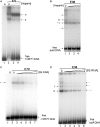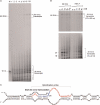Studies on the function of the riboregulator 6S RNA from E. coli: RNA polymerase binding, inhibition of in vitro transcription and synthesis of RNA-directed de novo transcripts
- PMID: 17332013
- PMCID: PMC1874619
- DOI: 10.1093/nar/gkm085
Studies on the function of the riboregulator 6S RNA from E. coli: RNA polymerase binding, inhibition of in vitro transcription and synthesis of RNA-directed de novo transcripts
Abstract
Escherichia coli 6S RNA represents a non-coding RNA (ncRNA), which, based on the conserved secondary structure and previous functional studies, had been suggested to interfere with transcription. Selective inhibition of sigma-70 holoenzymes, preferentially at extended -10 promoters, but not stationary-phase-specific transcription was described, suggesting a direct role of 6S RNA in the transition from exponential to stationary phase. To elucidate the underlying mechanism, we have analysed 6S RNA interactions with different forms of RNA polymerase by gel retardation and crosslinking. Preferred binding of 6S RNA to Esigma(70) was confirmed, however weaker binding to Esigma(38) was also observed. The crosslinking analysis revealed direct contact between a central 6S RNA sequence element and the beta/beta' and sigma subunits. Promoter complex formation and in vitro transcription analysis with exponential- and stationary-phase-specific promoters and the corresponding holoenzymes demonstrated that 6S RNA interferes with transcription initiation but does not generally distinguish between exponential- and stationary-phase-specific promoters. Moreover, we show for the first time that 6S RNA acts as a template for the transcription of defined RNA molecules in the absence of DNA. In conclusion, this study reveals new aspects of 6S RNA function.
Figures







Similar articles
-
6S RNA binding to Esigma(70) requires a positively charged surface of sigma(70) region 4.2.Mol Microbiol. 2009 Jul;73(2):152-64. doi: 10.1111/j.1365-2958.2009.06758.x. Epub 2009 Jun 16. Mol Microbiol. 2009. PMID: 19538447 Free PMC article.
-
The secret to 6S: regulating RNA polymerase by ribo-sequestration.Mol Microbiol. 2009 Jul;73(2):137-40. doi: 10.1111/j.1365-2958.2009.06759.x. Epub 2009 Jun 17. Mol Microbiol. 2009. PMID: 19538446 Free PMC article.
-
Synthesis-mediated release of a small RNA inhibitor of RNA polymerase.Science. 2006 Dec 8;314(5805):1601-3. doi: 10.1126/science.1134830. Science. 2006. PMID: 17158328
-
Regulation of transcription by 6S RNAs: insights from the Escherichia coli and Bacillus subtilis model systems.RNA Biol. 2014;11(5):508-21. doi: 10.4161/rna.28827. Epub 2014 Apr 23. RNA Biol. 2014. PMID: 24786589 Free PMC article. Review.
-
6S RNA - an ancient regulator of bacterial RNA polymerase rediscovered.Biol Chem. 2005 Dec;386(12):1273-7. doi: 10.1515/BC.2005.144. Biol Chem. 2005. PMID: 16336121 Review.
Cited by
-
Identification of novel small RNAs and characterization of the 6S RNA of Coxiella burnetii.PLoS One. 2014 Jun 20;9(6):e100147. doi: 10.1371/journal.pone.0100147. eCollection 2014. PLoS One. 2014. PMID: 24949863 Free PMC article.
-
6S RNA binding to Esigma(70) requires a positively charged surface of sigma(70) region 4.2.Mol Microbiol. 2009 Jul;73(2):152-64. doi: 10.1111/j.1365-2958.2009.06758.x. Epub 2009 Jun 16. Mol Microbiol. 2009. PMID: 19538447 Free PMC article.
-
Dom34 Links Translation to Protein O-mannosylation.PLoS Genet. 2016 Oct 21;12(10):e1006395. doi: 10.1371/journal.pgen.1006395. eCollection 2016 Oct. PLoS Genet. 2016. PMID: 27768707 Free PMC article.
-
From bacteria to humans, chromatin to elongation, and activation to repression: The expanding roles of noncoding RNAs in regulating transcription.Crit Rev Biochem Mol Biol. 2009 Jan-Feb;44(1):3-15. doi: 10.1080/10409230802593995. Crit Rev Biochem Mol Biol. 2009. PMID: 19107624 Free PMC article. Review.
-
Regulation of transcription from two ssrS promoters in 6S RNA biogenesis.Mol Cells. 2013 Sep;36(3):227-34. doi: 10.1007/s10059-013-0082-1. Epub 2013 Jul 16. Mol Cells. 2013. PMID: 23864284 Free PMC article.
References
-
- Suzuma S, Asari S, Bunai K, Yoshino K, Ando Y, Kakeshita H, Fujita M, Nakamura K, Yamane K. Identification and characterization of novel small RNAs in the aspS-yrvM intergenic region of the Bacillus subtilis genome. Microbiology. 2002;148:2591–2598. - PubMed
-
- Ando Y, Asari S, Suzuma S, Yamane K, Nakamura K. Expression of a small RNA, BS203 RNA, from the yocI-yocJ intergenic region of Bacillus subtilis genome. FEMS Microbiol. Lett. 2002;207:29–33. - PubMed
-
- Brown JW, Ellis JC. Comparative Analysis of RNA Secondary Structures: 6S RNA. Weinheim: Wiley-VCH GmbH & Co; 2005. pp. 491–512.
-
- Wassarman KM, Storz G. 6S RNA regulates E. coli RNA polymerase activity. Cell. 2000;101:613–623. - PubMed
MeSH terms
Substances
LinkOut - more resources
Full Text Sources
Other Literature Sources
Molecular Biology Databases

